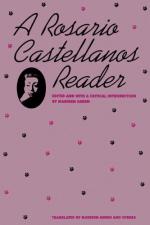|
This section contains 4,652 words (approx. 16 pages at 300 words per page) |

|
SOURCE: “Rosario Castellanos and the Structures of Power,” in Contemporary Women Authors of Latin America, edited by Doris Meyer and Margarite Fernandez-Olmos, Brooklyn College Press, 1983, pp. 22-31.
In the following essay, Anderson discusses Castellanos's exploration of women and power.
In 1950 Rosario Castellanos (1925-1974) presented a thesis on feminine culture which has come to be considered the intellectual point of departure for the women's liberation movement in Mexico.1 According to Mexican essayist, Carlos Monsiváis, no one up to that time had expressed so clearly what it meant to be both a woman and a Mexican.2 This became, in effect, the central line of Castellanos' work, but always from a very particular perspective: the relationship of women to their culture within the broader relationship in Mexican society of those with power to those deprived of it.
Although her 1973 book of essays, Mujer que sabe latín … (Woman Who Knows...
|
This section contains 4,652 words (approx. 16 pages at 300 words per page) |

|


